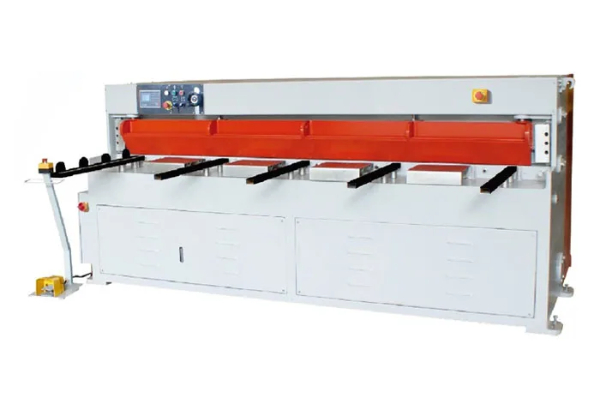
Precision Engineering- Understanding the Mechanics of Sheet Press Machines
- By:Metmac
- 2024-05-08
- 170
Introduction:
Precision Engineering: Understanding the Mechanics of Sheet Press Machines is a comprehensive guide to the intricacies of sheet metal fabrication, providing a deep dive into the principles and practices that govern the operation of these sophisticated machines. Catering to both novices and seasoned professionals alike, this article unveils the complexities of sheet press machines, delving into their design, mechanics, capabilities, and applications.
Dynamics of Sheet Press Machines
At the heart of a sheet press machine lies a carefully calibrated system of forces and motions. The machine’s ram, powered by hydraulic or mechanical means, exerts a controlled downward force on the sheet metal, pressing it into a die cavity. The die, precisely machined to the desired shape, imparts its contours onto the metal, creating the desired workpiece.
Types of Sheet Press Machines
The diverse landscape of sheet press machines encompasses a wide range of designs and capabilities. Mechanical presses, driven by a crankshaft-driven eccentric, offer high-speed operation and are well-suited for mass production. Hydraulic presses, on the other hand, provide exceptional precision and control for intricate or large-scale parts.
Critical Parameters in Sheet Pressing
Achieving optimal results in sheet pressing requires meticulous attention to a myriad of critical parameters. These include:
Press Force: The force exerted by the ram onto the die, determining the extent of deformation in the sheet metal.
Stroke Length: The vertical distance traveled by the ram, defining the depth of the formed part.
Die Clearance: The gap between the die and the punch, influencing material flow and part quality.
Hold Time: The duration that the sheet metal is held under pressure, affecting the material’s settling and springback properties.
Advanced Capabilities of Sheet Press Machines
Modern sheet press machines are equipped with an array of advanced features that enhance their versatility and precision. These include:
Computer Numerical Control (CNC): Enables precise programming and automation of the press process, improving repeatability and reducing human error.
Laser Cutting Integration: Combined with lasers for intricate cutting and etching, enabling complex part geometry and reduced material waste.
Servo Motors: Provide precise control over ram movement, enhancing part accuracy and consistency.
Applications of Sheet Press Machines
The versatility of sheet press machines extends to a vast range of industries, including:
Automotive: Manufacturing of body panels, chassis components, and engine parts.
Aerospace: Production of aircraft wings, fuselages, and structural elements.
Electronics: Fabrication of enclosures, housings, and heat sinks.
Medical: Creation of surgical instruments, implants, and prosthetic devices.
Conclusion:
Precision Engineering: Understanding the Mechanics of Sheet Press Machines is an invaluable resource for engineers, fabricators, and anyone seeking to master the art of sheet metal forming. By comprehensively examining the principles, capabilities, and applications of these versatile machines, this article empowers professionals to optimize their processes, achieve superior product quality, and drive innovation in their respective industries.
-
Advanced Sheet Metal Rolling, Cutting, and Folding Machines for Efficient Fabrication
2025/10/22 -
High-Precision Sheet Metal Bending and Cutting Solutions for Modern Manufacturing
2025/10/22 -
High-Precision Solutions from Leading Sheet Metal Cutting Machine Manufacturers
2025/09/11 -
Reliable Sheet Metal Equipment for Sale to Support Precision Fabrication
2025/07/17
-
Advanced Sheet Metal Rolling, Laser Cutting, and Folding Machines for Precision Fabrication
2025/10/31 -
High-Performance Sheet Metal Bending and Cutting Machines for Modern Fabrication
2025/10/31 -
High-Quality Sheet Metal Equipment for Sale: Efficient Solutions for Modern Manufacturing
2025/10/31 -
High-Performance Sheet Metal Equipment for Sale: Forming and Shearing Solutions for Modern Fabrication
2025/10/22
-
Integrating Automation with Rectangular Duct Machines for Enhanced Productivity
2024/05/11 -
Metal Shear Machines- Essential Tools for Precision Metal Cutting
2024/05/11 -
Understanding the Role and Function of Steel Strip Slitting Machines
2024/05/11 -
Maintenance Tips for Longevity of HVAC Duct Machines
2024/05/11
-
A Guide to the Latest Innovations in Sheet Metal Folding Machines
2024/11/29 -
Key Features to Consider When Investing in a Sheet Metal Folding Machine
2024/11/28 -
Enhancing Precision with Advanced Sheet Metal Folding Machines
2024/11/27 -
How to Choose the Right Sheet Metal Folding Machine for Your Workshop
2024/11/26






